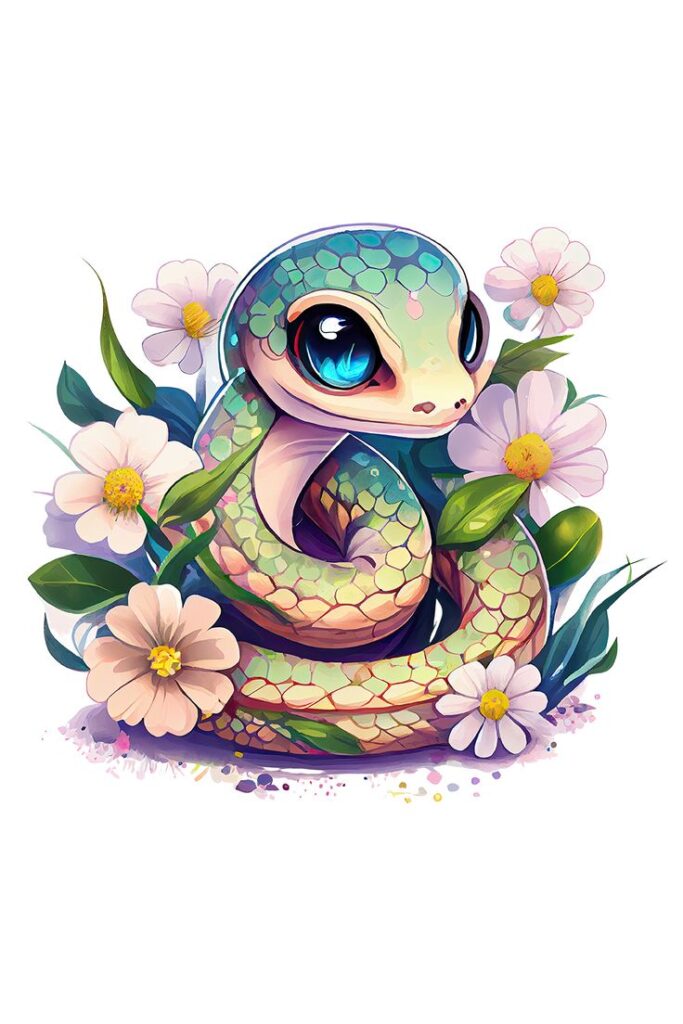Drawing snakes can be an engaging and rewarding artistic endeavor. To successfully draw snakes, one must focus on their unique shapes, textures, and patterns. Understanding how to capture the fluidity and grace of these creatures can elevate an artist’s skills and provide a sense of accomplishment.


With various species exhibiting distinct features, artists can challenge themselves by exploring different styles and techniques. The goal is not merely to replicate a snake’s appearance but to convey its movement and personality on the page. By honing observational skills, the artist can bring these fascinating reptiles to life through their drawings.
Whether one is a novice or an experienced artist, the process of learning to draw snakes offers valuable insights into anatomy, shading, and perspective. This journey can inspire creativity and deepen appreciation for the beauty of these often-misunderstood animals.
The Natural History of Snakes
Snakes possess a rich natural history that encompasses their evolutionary background, unique physical characteristics, and vast diversity within the classification of reptiles. Understanding these aspects provides insights into their adaptability and ecological roles.
Evolutionary Background
Snakes evolved from lizard ancestors during the late Cretaceous period, approximately 100 million years ago. This transition involved the loss of limbs and the development of elongated bodies. Fossil records show that early snakes, such as Tetrapodophis, had vestigial limbs.


The evolutionary adaptations allowed snakes to occupy various ecological niches. Key adaptations include carnivorous diets and specialized hunting techniques like constriction and venom. Modern snakes belong to the suborder Serpentes, further showcasing their evolutionary journey from lizards.
Physical Characteristics
Snakes exhibit several distinctive physical traits that differentiate them from other reptiles. They possess elongated, limbless bodies covered in scales, which serve multiple functions including protection, moisture retention, and temperature regulation.
The skull structure of snakes is highly specialized, featuring flexible jaws that accommodate large prey. They lack external ears and eyelids, with their eyes protected by a clear scale. Many species also possess specialized sensory organs, like heat-sensing pits in pit vipers, allowing them to detect warm-blooded prey.
Diversity and Classification
Snakes belong to the suborder Serpentes, which comprises approximately 3,000 species categorized into two main families: Colubridae (non-venomous) and Viperidae (venomous).
These families include well-known species such as the garter snake and the rattlesnake. Snakes inhabit various ecosystems, from deserts to rainforests, adapting their behavior and physiology to survive. The diversity in size, color, and patterns enhances their camouflage and hunting effectiveness, aiding in their survival in diverse environments.
Fundamentals of Drawing


Proficient drawing involves a combination of appropriate materials, an understanding of shapes, effective shading techniques, and a grasp of perspective and composition. Mastering these fundamentals enables artists to create more accurate and expressive representations.
Drawing Materials and Tools
Selecting the right materials is crucial for any drawing. Common tools include:
- Pencils: Range from hard (H) to soft (B), affecting shading and detail.
- Paper: Varies in texture and weight; smooth paper is ideal for fine details, while textured paper works well for softer effects.
- Erasers: Kneaded erasers lift graphite without tearing paper, while vinyl erasers are effective for broader corrections.
Different tools yield various effects. For instance, colored pencils provide vibrancy, charcoal allows for bold textures, and ink produces clean lines. Experimenting with these materials helps artists find their preferred mediums.
Understanding Shapes and Forms
Drawing requires breaking down complex subjects into basic shapes. This simplifies the process and enhances accuracy.
- Geometric Shapes: Circles, squares, and triangles form the foundation of most objects. For instance, a snake’s body can initially be represented by elongated ovals.
- Organic Shapes: Capturing the natural curves and lines in forms is key. Recognizing these shapes aids in representing the anatomy of snakes accurately.
Observation is essential. Artists should study real-life snakes and reference images to understand the unique features of different species, including texture, scale arrangement, and body contour.
Shading Techniques
Shading adds depth and dimension to drawings. Key techniques include:
- Hatching: Using parallel lines to create texture or shadow.
- Cross-Hatching: Layering lines in different directions for darker areas.
- Stippling: Applying dots to build shading; effective for subtle transitions.
Understanding light sources is vital for realistic shading. Artists should observe how light interacts with the subject, creating highlights and shadows. Experimenting with techniques will help find the best approach for representing textures on a snake’s skin.
Perspective and Composition
Perspective determines how objects are viewed in relation to one another. This enhances realism and spatial awareness in drawings.
- One-Point Perspective: Converges towards a single point, ideal for drawing a snake coiling towards the viewer.
- Two-Point Perspective: Utilizes two vanishing points, useful for depicting snakes on a slanted surface.
Composition involves arranging elements in a drawing harmoniously. Employing the rule of thirds, where key elements are placed off-center, can create engaging visual interest. Artists should consider how to lead the viewer’s eye through the artwork, focusing on key features like a snake’s head or unique patterns.
Drawing Snakes Step by Step
This guide provides clear steps for creating a snake drawing, from the initial outline to the finishing touches. Each step focuses on essential techniques to achieve a lifelike appearance while incorporating detail and color.
Sketching the Basic Outline
Begin by lightly sketching the snake’s shape using simple lines. Focus on the general posture, whether it’s coiled, slithering, or resting.
Use a pencil for flexibility, allowing easy adjustments. Start with the head, drawing an oval or triangular shape depending on the snake species. Following this, create a long, curved line for the body, tapering it as it extends. Add guidelines for the tail and regions where the body bends.
Ensure proportions are correct by referencing images of real snakes. This foundation will support further detailing. Remember, accuracy at this stage is crucial for overall visual interest.
Detailing the Scales and Texture


After establishing the outline, start adding detailed scales. Snakes have unique scales that can vary by species. Use small, curved lines to mimic these scales along the body, applying inconsistent spacing for a natural effect.
Vary the size of the scales; larger scales might exist on the snake’s belly, while smaller scales cover its back. Observe texture by using cross-hatching or stippling techniques for depth. This adds realism to the drawing.
Focus on the head, ensuring the detailing aligns with the snake’s unique facial features, such as the eyes and mouth. Incorporate different scale shapes and sizes for added authenticity.
Adding Color and Patterns
Color significantly enhances a snake drawing’s realism. Select appropriate colors based on the chosen snake species. Start with base colors, applying them lightly using colored pencils or watercolors.
Layer colors by gradually adding darker shades to create dimension. For example, a green snake may have lighter greens for the underside and darker for the back. Patterns, such as stripes or spots, can be added using fine-tipped pens or pencils to ensure precision.
Ensure transitions between colors are smooth to convey an organic look. Test colors on a separate sheet to identify the right shades that enhance visual appeal without overwhelming the design.
Creating Realistic Shadows
Shadows play a vital role in adding depth. Analyze your light source to determine where shadows will fall on the snake. Use a soft pencil or charcoal to apply shading underneath the belly and along the sides.
Keep the pressure light initially, gradually intensifying for darker areas. Blend shadows with a blending stump or finger to soften harsh lines, mimicking natural light.
Incorporate highlights using an eraser on areas that catch light, such as the top of the head and back. This contrast elevates the drawing, making it appear more three-dimensional and lifelike.
Anatomical Accuracy in Snake Art


Artistic representations of snakes require attention to their anatomical features. Accuracy in depicting their unique characteristics enhances both realism and appreciation for these creatures. Key aspects include studying snake anatomy, understanding musculature and movement, and capturing distinct facial features.
Studying Snake Anatomy
To achieve anatomical accuracy, artists must first study snake anatomy. This involves examining the skeletal structure, organ placement, and skin texture. Specific features, such as the unique arrangement of scales, contribute to the species’ identification.
Resourceful References:
- Field guides on reptiles
- Museums housing preserved specimens
Artists often use photographs for visual reference or, when possible, observe live snakes in natural settings. A comprehensive knowledge of anatomy helps prevent common mistakes and clichés.
Musculature and Movement
Snakes exhibit distinctive musculature that aids in their unique mode of locomotion. Understanding how muscle groups work together enables artists to represent realistic movement and posture.
Key muscle groups include:
- Longitudinal muscles: Allow for body elongation and contraction.
- Lateral muscles: Enable side-to-side movement.
These muscles contribute to how snakes slither, coil, or strike. Observing live movement or studying slow-motion videos can provide insights into different positions and dynamic actions. Artists should emphasize the flow and grace of a snake’s movement in their artwork.
Facial Features and Expression
Facial features in snakes are crucial for conveying emotion and character. Artists should focus on the shape of the head, arrangement of the eyes, and detail of the scales around the mouth. These elements significantly affect the overall impression of the snake.
Key Features to Consider:
- Eyes: Reflect different moods — from alertness to aggression.
- Mouth and tongue: The language of communication in snakes.
The unique patterns and colors of snake heads also play a role in captivating representation. Accurate facial features can bring a snake to life in art, drawing viewers’ attention to its innate beauty.
Incorporating Snakes into Various Art Styles


Snakes can be represented in diverse art styles, each offering unique interpretations. These approaches allow artists to explore the physical and symbolic aspects of snakes in ways that resonate with different audiences.
Realism and Hyperrealism
In realism and hyperrealism, artists focus on capturing the intricate details and textures of snakes. This style emphasizes accuracy in colors, scales, and anatomical features.
Techniques include:
- Observation: Artists often study live snakes or high-quality photographs.
- Layering: Multiple layers of paint or pencil strokes enhance depth.
- Lighting: Attention to how light interacts with scales adds to lifelike representation.
Realistic portrayals convey a sense of wonder and respect for these creatures, often highlighting their role in the ecosystem.
Stylization and Abstract Art
Stylization and abstract art provide freedom to reinterpret snakes using simplified forms and exaggerated features. This approach prioritizes emotion and personal expression over realism.
Common elements include:
- Shapes: Artists might use curves and lines to convey movement.
- Colors: Bright or unusual colors can evoke specific feelings or themes.
- Patterns: Incorporating geometric designs can create visual interest.
Through stylization, artists can challenge viewers’ perceptions and provoke thought about the symbolism associated with snakes.
Cartooning and Caricature
In cartooning, snakes are often depicted with exaggerated features and playful traits. This style emphasizes humor and can simplify the snake’s form for wider appeal.
Key aspects involve:
- Exaggeration: Features like wide eyes or oversized bodies enhance personality.
- Expression: Snakes might be shown smiling or interacting with other characters.
- Storytelling: Cartoons often place snakes in narratives that engage audiences.
This playful representation can serve to educate or entertain, making snakes approachable and relatable.
Ethical Considerations in Snake Art
Artists creating snake art must navigate various ethical considerations that influence their work. Key aspects include promoting conservation and ensuring accurate representations of these creatures.
Conservation Messages
Art can serve as a powerful tool for conservation. Artists have the ability to raise awareness about endangered snake species and their habitats. By depicting snakes in their natural environments, they can educate the public on the importance of preserving biodiversity.
Incorporating facts about threats to snakes, such as habitat loss and climate change, can enhance the impact of the artwork. Using art for campaigns helps to engage communities and inspire action towards protecting snake populations and their ecosystems.
Artists should also support conservation organizations through donations or collaborative events. This demonstrates a commitment to the cause and can further amplify the message within their artworks.
Avoiding Misrepresentation
Accurate depiction of snakes is crucial in avoiding misrepresentation. Many people hold misconceptions about snakes that can lead to fear or misunderstanding. Artists need to research the specific species they portray, respecting their behaviors, habitats, and ecological roles.
Misleading imagery can contribute to negative stereotypes, affecting public perception and conservation efforts. By focusing on accuracy, artists contribute to a more informed understanding of snakes within both the art community and society at large.
It is important for artists to acknowledge cultural contexts and traditional beliefs surrounding snakes, ensuring sensitivity in representation. Engaging with herpetologists or wildlife experts can provide valuable insights and enhance authentic representation.
Digital Techniques for Drawing Snakes
Digital techniques provide artists with powerful tools to create realistic and imaginative snake illustrations. Utilizing various software, brushes, and layer effects can significantly enhance the drawing process.
Digital Drawing Software Overview
Several digital drawing programs cater to different styles and skill levels. Popular options include:
- Adobe Photoshop: Offers advanced features for painting and editing, ideal for detailed snake textures.
- Procreate: Known for its intuitive interface, suitable for sketching and illustration on tablets.
- Corel Painter: Mimics traditional media, providing a natural feel while drawing snakes.
Each software provides unique tools and capabilities, allowing artists to choose what aligns best with their techniques and desired outcomes.
Brushes and Textures
Choosing the right brushes is essential for achieving different snake skin textures. Various brushes can mimic scales, smooth surfaces, and shadows.
- Texture Brushes: Help simulate the unique patterns of snake skin.
- Soft Brushes: Useful for creating smooth gradients and highlights.
- Custom Brushes: Artists can create or download brushes specifically designed for snakes.
Incorporating textures into the artwork adds depth, making snakes appear more lifelike. Experimenting with opacity and flow settings also enhances the final look.
Layer Management and Effects
Layer management is crucial for organizing elements in snake illustrations. It allows for non-destructive editing and easier adjustments. Key practices include:
- Separate Layers: Use different layers for outlines, colors, and details.
- Layer Effects: Apply shadows and highlights to add dimension.
- Clipping Masks: Restrict effects to specific layers, enhancing focus on certain areas.
Understanding layer functions improves workflow efficiency and contributes to cleaner, more polished digital artwork. This method ensures flexibility to iterate on designs without starting from scratch.
Inspiring Examples of Snake Art
Snake art can be found in various cultures and forms, showcasing the versatility and beauty of these creatures. Here are some notable examples that inspire artists.
Ancient Egyptian Art: Snakes symbolized protection and royalty. Iconic depictions include the Uraeus, a stylized cobra, frequently seen on pharaohs’ crowns.
Japanese Tattoos: In Japan, snakes are often depicted in traditional tattoos, symbolizing good fortune and protection. The intricate designs highlight the fluidity and grace of snakes.
Contemporary Sculpture: Artists like Anish Kapoor create large-scale sculptures that incorporate snake imagery, inviting viewers to explore themes of nature and identity.
Native American Art: Various tribes feature snakes in their art, often representing rebirth and transformation. These artworks can include pottery, beadwork, and carvings.
Digital Art: Modern digital artists utilize tools like Photoshop and Procreate to create vibrant snake illustrations. These pieces often blend realism with fantasy.
Key Characteristics of Snake Art
| Art Form | Features | Cultural Significance |
|---|---|---|
| Ancient Egypt | Cobras, hieroglyphs | Protection, royalty |
| Tattoos | Detailed, colorful designs | Good fortune, spirituality |
| Sculpture | Large, abstract representations | Nature, identity exploration |
| Native American | Pottery, beadwork, carvings | Rebirth, transformation |
| Digital Art | Vibrant illustrations, mixed styles | Modern expressions |
These examples reflect the diverse representation of snakes across cultures and media, inspiring many artists today.
Improving Your Snake Drawings


To enhance snake drawing skills, the importance of consistent practice, open feedback, and studying expert artists cannot be overstated. Each of these areas provides crucial insights and techniques that help an artist refine their work.
Practice and Consistency
Regular practice is essential for mastering snake drawings. Setting aside dedicated time each day or week allows an artist to experiment with different styles and techniques.
Key Techniques:
- Focus on basic shapes: Start with simple forms like ovals and lines to capture the essence of a snake’s body.
- Vary the species: Draw various snake species to understand unique features like patterns and textures.
Keeping a sketchbook can also help track progress and identify areas that need improvement. Engaging in challenges, such as drawing from photographs or nature, can further stimulate creativity and skill development.
Feedback and Critique
Receiving constructive feedback is crucial for improvement. Sharing work with peers or joining art communities can provide insights into strengths and weaknesses.
Effective Feedback Strategies:
- Request specific advice: Asking for opinions on details, such as proportion or shading, leads to targeted improvements.
- Be open-minded: Accept critique gracefully and view it as a tool for growth rather than criticism.
Additionally, participating in workshops or online classes allows artists to benefit from the experience of instructors and fellow artists. This interaction can greatly speed up the learning process.
Studying Master Artists


Analyzing the work of master artists is a valuable learning tool. By observing their techniques, artists can gain insights into how to effectively depict snakes.
Learning Points:
- Study their lines: Notice how they create fluidity and movement in snake forms.
- Observe color choices: Understanding how colors influence mood can enhance an artist’s palette.
Creating copies of master works can also be beneficial. This practice allows artists to internalize techniques that make the artwork successful, ultimately informing their personal style and drawing capabilities.
- 23.4Kshares
- Facebook0
- Pinterest23.3K
- Twitter3
- Reddit0













